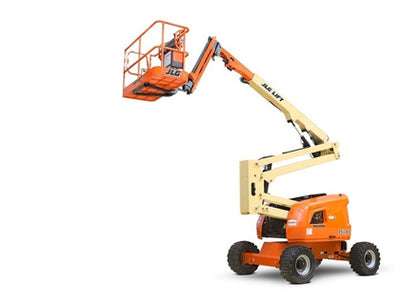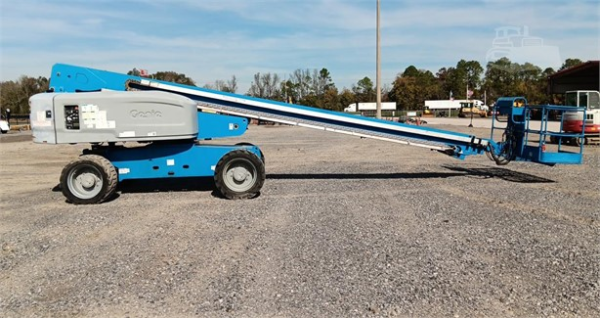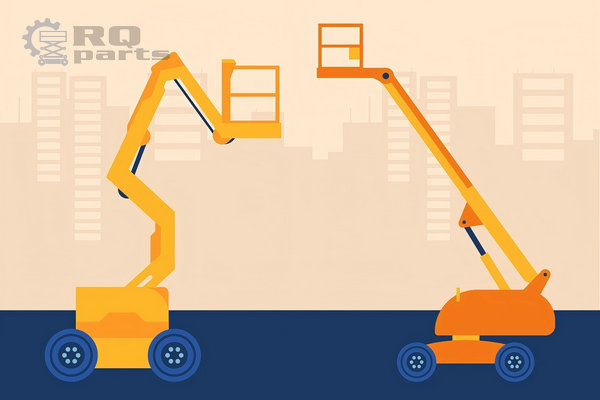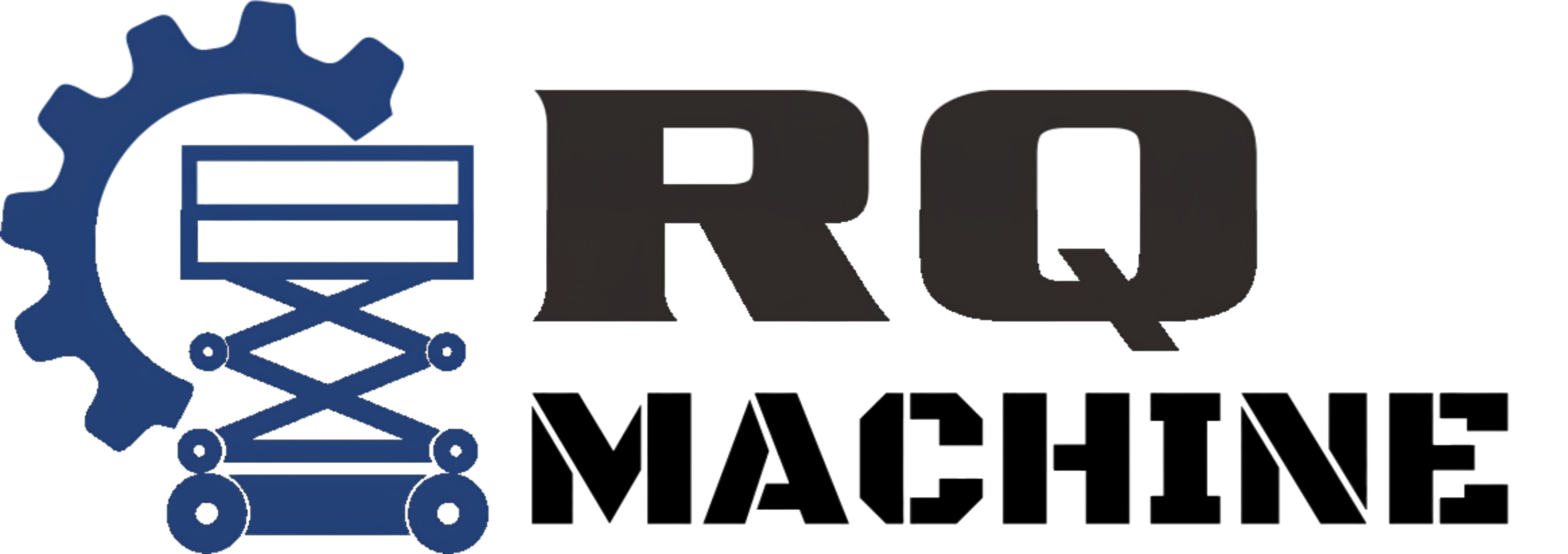Articulating vs. Telescopic Boom Lifts: What Are The Differences
2025-10-17
When it comes to working at height, boom lifts are indispensable tools for construction, maintenance, and industrial operations. Among the various types of aerial work platforms, Articulating Boom Lifts and Telescopic Boom Lifts are two of the most widely used. While they may appear similar at first glance, they serve different purposes depending on the work environment and application needs.
As a professional manufacturer and supplier of aerial equipment, RQ Machines provides both articulating and telescopic boom lifts designed to deliver superior performance, safety, and efficiency.
Let’s explore their key differences and learn how to choose the right one for your project.
1. What Is an Articulating Boom Lift?
An Articulating Boom Lift, also known as a Knuckle Boom Lift, features multiple hinged sections that can bend, extend, or rotate. This unique design allows the lift to reach over and around obstacles, making it ideal for working in confined or hard-to-reach areas.

Key Features:
-
Multi-jointed arms (articulated design)
-
Excellent maneuverability around obstacles
-
Suitable for both indoor and outdoor operations
-
Compact turning radius for tight spaces
Common Applications:
-
Building maintenance and window cleaning
-
Electrical and mechanical installations
-
Tree trimming and landscaping
-
Industrial plant repair and inspection
At RQ Machines, our articulating boom lifts are engineered for maximum flexibility and stability, helping workers access even the most complex work environments safely and efficiently.
2. What Is a Telescopic Boom Lift?
A Telescopic Boom Lift, often called a Straight Boom Lift, features a single extendable arm that moves up and out in a straight line. This design enables operators to reach greater vertical and horizontal distances quickly, making it ideal for open and high-reach jobs.

Genie S80 Telescopic Boom Lift
Key Features:
-
Straight extending arm (telescopic design)
-
Longer horizontal outreach compared to articulating models
-
Fast lifting speed and simple operation
-
Excellent stability on rough terrains
Common Applications:
-
Construction sites and large-scale infrastructure projects
-
Bridge and tower maintenance
-
Shipyard and port operations
-
Outdoor painting and signage installation
RQ Machines offers heavy-duty telescopic boom lifts equipped with powerful engines and all-terrain tires, ensuring reliable performance even in the most demanding job sites.
Key Differences Between Articulating and Telescopic Boom Lifts
| Feature | Articulating Boom Lift | Telescopic Boom Lift |
|---|---|---|
| Design | Multiple jointed arms (knuckle type) | Straight telescopic arm |
| Reach Type | Can go “up and over” obstacles | Extends in a straight line |
| Best For | Tight spaces and complex environments | Open areas and long-distance reach |
| Maneuverability | Very flexible, great for confined areas | Limited flexibility but higher reach |
| Operation Speed | Slightly slower due to articulation | Faster lifting and extension |
| Typical Industries | Maintenance, warehousing, electrical work | Construction, infrastructure, ports |
| Cost | Generally higher due to complex design | Often more affordable for long-reach tasks |
Both types have their advantages — the best choice depends on your specific job site requirements.

Structural & Operational Differences
The most significant distinction lies in the boom arm’s structure and movement.
| Feature | Articulating Boom Lift (Knuckle Boom) | Telescopic Boom Lift (Straight Boom) |
| Boom Arm | Multiple hinged sections (joints/knuckles). | Straight, rigid sections that slide in and out (telescope). |
| Movement | Up-and-Over motion. Can bend and maneuver around obstacles (e.g., pipes, beams). | Straight-Out and vertical motion. Extends in a linear direction. |
| Maneuverability | High maneuverability in tight, congested spaces. Excellent for indoor or complex outdoor sites. | Limited maneuverability; requires a clear line of sight to the target. |
| Horizontal Reach | Good, but often limited by the articulation points. | Superior. Offers the longest horizontal outreach possible among AWPs. |
| Vertical Reach | Excellent, but typically reaches a lower maximum height than its telescopic counterpart. | Superior. Can reach the highest vertical working heights (up to 210 ft+). |
Application Differences: Where Each Excels
The unique structural design dictates the ideal working environment for each lift type.
Articulating Boom Lifts (The Flexible Solution)
The Articulating Boom Lift is the ultimate problem-solver for complex access challenges.
- Obstacle Clearance: Ideal when you need to reach over or around permanent fixtures, such as machinery, shelving, pipes, or rooflines.
- Confined Spaces (Indoor & Outdoor): Perfect for crowded warehouses, indoor maintenance (HVAC, electrical, lighting), and urban settings where setup space is limited. Many electric articulating models offer non-marking tires and low noise.
- Maintenance & Inspection: Excellent for detailed work that requires multiple angular approaches, such as facade inspection or complex steel structure welding.
Telescopic Boom Lifts (The Maximum Reach Solution)
The Telescopic Boom Lift is designed for jobs requiring sheer height and distance.
- Max Height & Outreach: The preferred choice for skyscrapers, bridge construction, heavy industrial facilities, and large petrochemical plants.
- Unobstructed Access: Best used when you have a clear, direct path to the work area. The straight boom allows operators to get into position quickly.
- High Load Capacity: Due to its rigid, single-axis structure, the telescopic boom generally offers greater stability and often a higher platform weight capacity at full extension compared to an articulating model.
- Rough Terrain: Diesel-powered telescopic lifts often come with rugged 4WD and oscillating axles, making them excellent for large, unimproved construction sites.
Operational Considerations & Cost
| Consideration | Articulating Boom Lift | Telescopic Boom Lift |
| Maintenance | Potentially higher. More pivot points mean more grease points and potential wear areas. | Generally lower. Simpler, straight mechanical extension system. |
| Set-up Time | Can be slightly longer, as the operator must carefully maneuver the boom’s joints to avoid obstacles. | Faster. Extends directly to the target height/distance. |
| Power Source | Widely available in Electric (indoor/quiet operation) and Diesel (outdoor/power). | Predominantly Diesel for high-power, high-reach outdoor jobs. |
| Initial Cost | Varies, but the complexity of the “knuckle” mechanism can sometimes lead to a higher initial purchase price for comparable height. | Often lower than an articulating lift of similar reach. |
How to Choose Between Articulating and Telescopic Boom Lifts
When selecting the right boom lift, consider the following factors:
Work Environment
-
Choose an articulating boom lift if your site has obstacles such as beams, pipes, or structures that require maneuvering around.
-
Opt for a telescopic boom lift if your site is open and requires long, straight-line access.
Required Height and Outreach
-
Telescopic lifts typically offer higher vertical and horizontal reach.
-
Articulating lifts excel at reaching awkward or obstructed spots.
Terrain Conditions
-
For rough or uneven ground, both types can be equipped with four-wheel drive and stabilizers, but telescopic models often perform better outdoors.
Budget and Maintenance
-
Articulating models are slightly more expensive and complex to maintain, but they offer unmatched versatility.
-
Telescopic models have a simpler design and are cost-effective for repetitive high-reach jobs.
Why Choose RQ Machines Boom Lifts
RQ Machines specializes in providing high-performance aerial work platforms tailored to professional applications. Our range of articulating and telescopic boom lifts combines reliability, safety, and ease of operation to help you work smarter at height.
Advantages of Choosing RQ Machines:
-
Extensive product lineup for various height and reach requirements
-
CE and ISO certified equipment meeting international safety standards
-
Durable structure and advanced hydraulic system
-
Customizable configurations for different industries
-
Comprehensive after-sales support and spare parts availability
Whether you need to reach over obstacles or extend straight to great heights, RQ Machines has the right boom lift for your needs.
FAQ
Q1: Which lift is safer, articulating or telescopic?
Both are safe when operated correctly, but articulating lifts offer better control in confined spaces, while telescopic lifts provide superior stability for high-reach outdoor work.
Q2: Can boom lifts be used indoors?
Yes. Electric-powered articulating boom lifts are commonly used indoors because they produce no emissions and are quieter.
Q3: What is the maximum working height?
RQ Machines offers models with working heights ranging from 12m to 45m, depending on the lift type and configuration.
Q4: Do you provide after-sales service and spare parts?
Absolutely. RQ Machines provides global technical support, genuine spare parts, and maintenance guidance to ensure long-term reliability.
Conclusion
Both Articulating Boom Lifts and Telescopic Boom Lifts are essential tools for safe and efficient aerial work.
If your project involves navigating around obstacles, choose an articulating model. If you need maximum reach and speed in open environments, a telescopic model is ideal.
At RQ Machines, we offer a full range of aerial platforms designed to meet your exact requirements — delivering performance, safety, and value you can trust.
Contact RQ Machines today to get a customized quote and find the perfect boom lift for your business!
